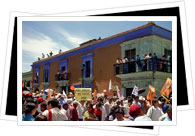|
The modern history of Oaxaca has seen an industry shift. Many visitors flock each year to enjoy the beautiful landscapes of the Valles Centrales and the architectural charm of Oaxaca City. In the last 25 years, tourism has undoubtedly become the principle supports to Oaxaca's modern day economy. Whilst much of the indigenous population disappeared during the colonial era, 16 different ethnic groups continue to inhabit the region, adding to its richness. Spanish is the most commonly used language but in the smaller villages and close-knit communities you may well hear a variety of different tongues. Check out our page on Oaxaca Language for more information.

Of most concern for visitors to the region has been the Oaxaca Protests. An ongoing feeling of unrest has been apparent during recent years after some teacher strikes in May 2006 lead to riots and violent protests in the city of Oaxaca.
What began as an innocent plea for higher wages resulted in the banning of the Oaxaca Teacher's Union and a huge amount of military intervention. The APPO (Popular Assembly for the towns of Oaxaca) backed the Oaxaca protests, accumulating thousands of members who were all against Oaxaca's governer Ulises Ruiz Ortíz.
October 2006 saw the Oaxaca protests get violent after the government called in the Paramilitary forces and riot police began to fight with bulldozers, tear gas and watercannons. In an attempt to oust the APPO from running the university radio station gas canisters were even dropped on the campus from helicopters. The Oaxaca protesters fought back by setting fire to vehicles and hurling rocks - this was no longer just a teacher's strike, but a people's plight to be heard by the authorities.
The ongoing disputes were continued with demostrations around the Oaxaca Zócalo which generally consisted of quiet protests around the city centre. However, on the 25th November 2006 the PFP (Federal Preventative Police) finally evicted the APPO in a violent riot in which many people were arrested, maltreated in custody and many of the buildings in Oaxaca's city centre suffered fire damage.
Since the end of 2006 the city has been a lot quieter. Occasional demostrations take place around the city but the Oaxaca Protests have not been a cause for violence again. The architecture that was damaged is being carefully restored and travellers are being encouraged to visit Oaxaca as a safe and tranquil destination.
However, as with all things, it is worth checking the news before you go to make sure nothing has kicked off again, but for the moment, Oaxaca protests are calm and things are returning back to normal.
|